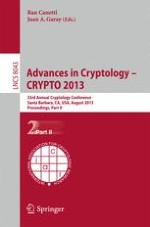2013 | OriginalPaper | Buchkapitel
A Dynamic Tradeoff between Active and Passive Corruptions in Secure Multi-Party Computation
verfasst von : Martin Hirt, Ueli Maurer, Christoph Lucas
Erschienen in: Advances in Cryptology – CRYPTO 2013
Verlag: Springer Berlin Heidelberg
Aktivieren Sie unsere intelligente Suche, um passende Fachinhalte oder Patente zu finden.
Wählen Sie Textabschnitte aus um mit Künstlicher Intelligenz passenden Patente zu finden. powered by
Markieren Sie Textabschnitte, um KI-gestützt weitere passende Inhalte zu finden. powered by
At STOC ’87, Goldreich et al. presented two protocols for secure multi-party computation (MPC) among
n
parties: The first protocol provides
passive
security against
t
<
n
corrupted parties. The second protocol provides even
active
security, but only against
t
<
n
/2 corrupted parties. Although these protocols provide security against the provably highest possible number of corruptions, each of them has its limitation: The first protocol is rendered completely insecure in presence of a single active corruption, and the second protocol is rendered completely insecure in presence of ⌈
n
/2 ⌉ passive corruptions.
At Crypto 2006, Ishai et al. combined these two protocols into a single protocol which provides passive security against
t
<
n
corruptions and active security against
t
<
n
/2 corruptions. This protocol unifies the security guarantees of the passive world and the active world (“best of both worlds”). However, the corruption threshold
t
<
n
can be tolerated only when
all
corruptions are passive. With a single active corruption, the threshold is reduced to
t
<
n
/2.
As our main result, we introduce a
dynamic tradeoff
between active and passive corruptions: We present a protocol which provides security against
t
<
n
passive corruptions, against
t
<
n
/2 active corruptions,
and everything in between
. In particular, our protocol provides full security against
k
active corruptions, as long as less than
n
−
k
parties are corrupted in total, for any unknown
k
.
The main technical contribution is a new secret sharing scheme that, in the reconstruction phase, releases secrecy
gradually
. This allows to construct non-robust MPC protocols which, in case of an abort, still provide some level of secrecy. Furthermore, using similar techniques, we also construct protocols for reactive MPC with hybrid security, i.e., different thresholds for secrecy, correctness, robustness, and fairness. Intuitively, the more corrupted parties, the less security is guaranteed.
